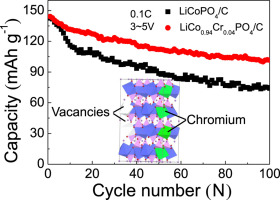Journal of Solid State Chemistry ( IF 3.2 ) Pub Date : 2017-09-01 , DOI: 10.1016/j.jssc.2017.08.039 Yue Wang , Junhong Chen , Jingyi Qiu , Zhongbao Yu , Hai Ming , Meng Li , Songtong Zhang , Yusheng Yang

|
Electrical and ionic conductivity are two major limiting factors for LiCoPO4 cathode material. To overcome these shortcomings, a Cr-substituted LiCoPO4 core with a conductive carbon layer cathode material is synthesized using the sol-gel method. The physical chemistry properties of these materials are systematically investigated by using various characterization methods. For instance, the XRD and Rietveld refinement results reveal that Cr successfully substitutes the Co within the LiCoPO4 core to form LiCo1-1.5xCrxPO4/C (x = 0, 0.02, 0.04, 0.06) without changing the olivine structure but exhibits a decrease in the unit cell volume with increasing Cr substitution. SEM and TEM images indicate that Cr substitution does not lead to changes in the basic morphology of LiCo1-1.5xCrxPO4/C (x = 0, 0.02, 0.04, 0.06) material, which is composed of agglomerated nanoparticles with an 8 nm carbon layer on the surface. The EDS and XPS results confirm that Cr is uniformly distributed on the surface and that the oxidation state of Cr is +3. FTIR spectra indicate that the antisite defect concentration decreases with increasing Cr substitution. Furthermore, Cr substitution significantly improves the electrochemical performances of LiCo1-1.5xCrxPO4/C (x = 0.02, 0.04, 0.06) cathode. Notably, the LiCo0.94Cr0.04PO4/C delivers an initial discharge capacity of 144 mA h g−1 at 0.1 C and shows a capacity retention of 71% after 100 cycles between 3.0 and 5.0 V. The CV and EIS results indicate that the polarization is reduced and that the electronic and ionic conductivities are improved by Cr substitution. The good electrochemical performances for Cr-substituted LiCoPO4/C electrodes are attributed to the lower antisite defect concentration, as the reduction of polarization, the improvement of electronic and ion conductivity and the uniform carbon layer. These features will accelerate the commercial application of LiCoPO4 towards the start-art of the high voltage lithium-ion batteries.
中文翻译:

具有导电碳层的Cr取代LiCoPO 4芯,用于高压锂离子电池
导电率和离子导电率是LiCoPO 4阴极材料的两个主要限制因素。为了克服这些缺点,使用溶胶-凝胶法合成了具有导电碳层阴极材料的Cr-取代的LiCoPO 4核。通过使用各种表征方法,系统地研究了这些材料的物理化学性质。例如,XRD和Rietveld精炼结果表明,Cr成功替代了LiCoPO 4核内的Co ,形成了LiCo 1-1.5x Cr x PO 4/ C(x = 0、0.02、0.04、0.06),而不会改变橄榄石结构,但随着Cr取代量的增加,单位晶胞体积会减小。SEM和TEM图像表明,Cr取代不会导致LiCo 1-1.5x Cr x PO 4 / C(x = 0、0.02、0.04、0.06)材料的基本形态发生变化,该材料由附聚有纳米颗粒的团聚纳米颗粒组成 表面上有8 nm的碳层。EDS和XPS结果证实Cr均匀地分布在表面上,并且Cr的氧化态为+3。FTIR光谱表明,随着Cr取代量的增加,抗位缺陷浓度降低。此外,Cr置换可显着改善LiCo 1-1.5x Cr的电化学性能x PO 4 / C(x = 0.02,0.04,0.06)阴极。值得注意的是,LiCo 0.94 Cr 0.04 PO 4 / C在0.1 C时的初始放电容量为144 mA h g -1, 并且在3.0至5.0 V之间的100个循环后显示出71%的容量保持率。CV和EIS结果表明: Cr取代可减少极化,并提高电子和离子电导率。Cr取代的LiCoPO 4的良好电化学性能/ C电极归因于较低的反位缺陷浓度,如极化的减少,电子和离子电导率的提高以及均匀的碳层。这些特征将加速LiCoPO 4的商业应用,朝着高压锂离子电池的起步技术发展。











































 京公网安备 11010802027423号
京公网安备 11010802027423号